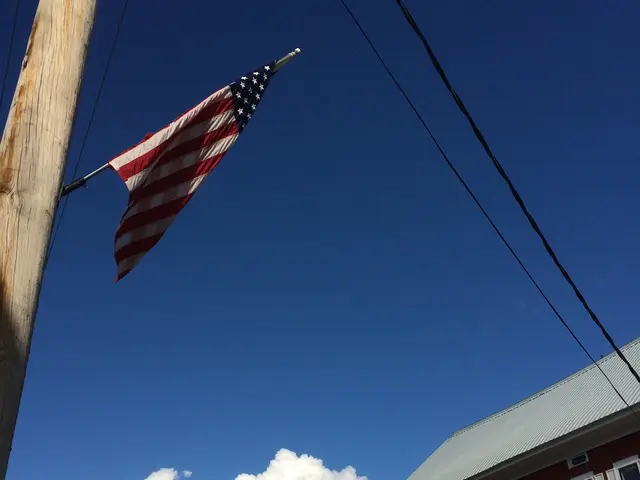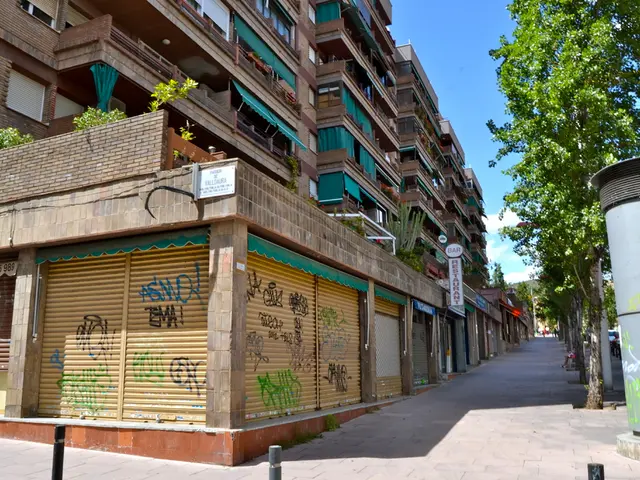Housing predicament in North Carolina worsens post-Hurricane Helene
Rebuilding Lives: Navigating the Aftermath of Hurricane Helene
Nestled in the hills of western North Carolina, the quaint town of Fairview was once a tranquil haven for residents Stuart and Jackie Pacheo. Their home, snug between a small creek and the highway, had been their sanctuary for three decades.
"We're standing where our living room used to be," Mr. Pacheo explains, gesturing to the mud-soaked ground. "The kitchen was behind you, a cozy fireplace to the left, and this is where we spent most of our time."
Now, the couple exists amidst remnants of their past life. Their home's foundation, barely visible, serves as a haunting reminder of their pre-Hurricane Helene existence. The storm ravaged the couple's peaceful haven, just one of the many victims of the monster that swept across the region last September.
Mrs. Pacheo reflects on the destruction with a mixture of sorrow and disbelief, eight months after the disaster. "Our property was once lush with trees. Now there are only a few left," she laments.
Climate change has turned storms into formidable foes, with hurricanes growing larger and wetter as they bring catastrophic amounts of rain to inland areas. The National Hurricane Center estimates that at least 249 lives were lost during Hurricane Helene and its aftermath, with 94 fatalities attributed to rainfall flooding alone.
The Pacheos, in their early sixties, were only mildly concerned when they learned a big storm was approaching. After all, they had weathered such threats before, their creek having flooded in the past without breaching their home. With Jackie recuperating from a knee injury on crutches and her cat refusing to leave, they decided to stay put and ride out the storm.
"We were sound asleep," Mrs. Pacheo recalls, "when my phone started blaring an emergency alert. It said 'Evacuate now. Get out now.'"
Buncombe County sent the warning to residents in low-lying areas as rivers and tributaries began to overflow. The couple grabbed what they could, rushed to Jackie's mother's house next door, which also was inundated.
"We had water coming at us from all directions," Mrs. Pacheo recalls, her voice filled with emotion. "It looked like a raging ocean."
From the second-story window of her mother's home, the couple watched in despair as their possessions, their vehicles, and their home were swept away by the relentless flood. The tragic stealing of their life's work still echoes in their hearts today.
"We feel torn," Mrs. Pacheo admits. "We're considering moving elsewhere, but I've lived here for most of my life. I'm tired. I'd like to forget about all this and move on."
However, the struggle to convey the imminent danger faced by the town goes far beyond the Pacheos' heartache. More than 100,000 homes were damaged or destroyed in North Carolina, with some 500 miles inland from where Helene made landfall in Florida.
Lilian Govus, the director of communications for Buncombe County, reflects on the county's efforts to warn people of the approaching storm.
"We knew a big storm was coming, but we couldn't capture the attention of our residents as we had hoped," Govus laments. She sought to use archival photos of the devastating 1916 flood as a warning, but to no avail. Two days before the storm hit, the county declared a state of emergency and encouraged evacuations in some communities, but only one media outlet attended the press conference.
Those who prepared for the storm still found themselves caught off guard. Jeffrey Burroughs, president of the River Arts District (RAD) in Asheville, recalls the struggles many artists faced in safeguarding their studios and artwork. Many moved their work to higher locations, even going so far as to move things onto the second floor. The floodwaters reached the second floor in some buildings, leaving the artists devastated.
"We had 750 artists working in the RAD before Helene," Burroughs notes. "Today, we have 350 artists back up and running, but we're looking to bring all those who lost their studios, artwork, equipment, and materials back home."
Burroughs and the RAD community are determined to create a more resilient district. They're working on reimagining the future of the district, focusing on rebuilding with creativity, floodproofing, and resilience.
For Sarah Bivins and her partner Barry Cooper, life goes on amidst the remembrances of the storm. Their farm, deeply steeped in mud and debris, once teemed with life and vitality. Their beloved chickens, trapped in their home during the flood, perished in the torrential waters.
"The sounds of the creek used to fill our home," Cooper says, his voice filled with sorrow. "During the storm, the water transformed into a roaring train."
They wonder if they should move somewhere else but have grown attached to their land and the knowledge passed down from generations of farmers and gardeners. They're committed to rebuilding their farm and preserving its essence.
"You're connected to thousands of years of wisdom," Cooper reflects. "It's the local community that helps you understand how to live in harmony with the land."
Communicating the risks faced by residents of low-lying areas remains a challenge. Localization of risk is a social phenomenon that makes it difficult for people to truly grasp the potential dangers to their personal lives. A migration to climate refuges has been encouraged, but climate change is progressing at a blistering pace, forcing a relook at preparedness strategies.
"We have friends from California who moved here because this was the place to be," says Govus. "But climate change is happening too quickly, and we never imagined the threats we now face."
In the wake of Helene, a renewed interest in preparedness has emerged. Evidence of the destruction remains everywhere in western North Carolina, with thousands still left homeless and struggling to rebuild.
Govus now sees a newfound appreciation for preparedness and readies for another hurricane season. In the end, however, the ultimate goal is to learn from the past and adapt, so future residents won't have to face the devastation that the people of Fairview have experienced.
Copyright 2025 NPR
- "Climate change, with its role in making storms larger and wetter, has brought unprecedented destruction, as seen by the devastating impact of Hurricane Helene on communities like Fairview."
- "Amidst the rubble and remnants, the once peaceful life of Fairview residents Stuart and Jackie Pacheo, now lies in shambles, highlighting the impact of climate change-driven disasters on housing and real estate."
- "Science and environmental-science have a crucial role to play in predicting and preparing for future climate-change events, with potentially massive investments needed to rebuild damaged infrastructure and homes."
- "Local news outlets, like Buncombe County, struggle to convey the urgency of the situation to residents, illustrating the need for better communication and education on climate change and its potential impacts on a community."
- "Communities, whether in Fairview, Asheville, or other low-lying areas, must adapt and evolve to survive in a climate-change-altered world, with the preservation of their traditional ways of life and environment playing a vital role."








